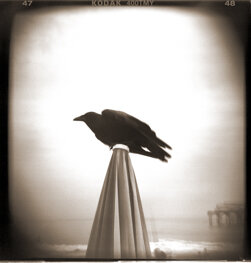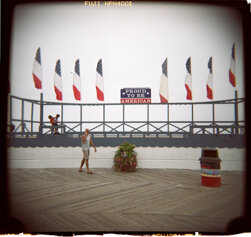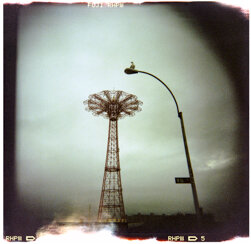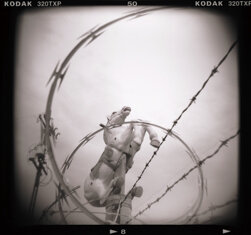Bryce Lankard explores time with ‘A Stationary Point on a Spinning Planet’ at Sulfur Studios
By John Singer/For Do Savannah
Get ready for an exhibition based on heavy contemplation as photographer Bryce Lankard displays three separate bodies of work in his latest exhibition at local Bull Street artists haven, Sulfur Studios. From practicing editorial and fine art photography to teaching photography at Duke Universities’ Center for Documentary Studies, Lankard has done it all behind the lens.
“I was really excited when Sulfur Studios offered me their main gallery space for this solo exhibition. It’s a very large space that offered me the opportunity to showcase a large selection from two related bodies of work,” he said. “The two photography projects are at their core a contemplation of the passage of time. ‘Blink of an Eye’ takes a macro view of this idea, while ‘Transience’ takes a micro approach. I also took this opportunity to create the short film for which the show is titled ‘A Stationary Point on a Spinning Planet’ to further unite this theme.”
″‘Blink of an Eye’ investigates the moments and places that one takes for granted and assumes will always be around that can disappear in the blink of an eye,” Lankard said. “The events surrounding both 9/11 and Hurricane Katrina brought this project into a deeper personal focus for me due to my long-standing connection with both of these unique cities. This sense of apparent sudden loss can be applied to physical objects, such as buildings or cities, and even to concepts like summertime, mortality, and youth.”
″‘Transience’ focuses on the randomness and impermanence of elements in motion, from objects moving through space to shifts of light as seen from a stationary point on a spinning planet,” he added. “Drawing from the aesthetic of wabi-sabi, which emphasizes the beauty of imperfection and the transience of time, these images reflect the rhythms of our world unfolding through sequencing, layering or mirroring. I hope these images encourage the viewer to slow down, observe, and take notice of those briefest moments of beauty that happen daily all around us but often slip by unnoticed.”
For the third and final piece of Lankard’s puzzle, he’ll be premiering a new film project that dives into the outer realms of our understanding. ″‘A Stationary Point on a Spinning Planet’ captures the atomic flickers of human existence in the midst of the wonder of nature’s perfect imperfections. It encourages a temporal shift in the viewers’ perception of the moments that pass us by, the innuendos of our brief encounter with this world.
While much of Lankard’s work falls into the documentary tradition, he hopes to express more personal ideas as well. “I hope these concepts also have a universal message, that each viewer will find their own personal connection to the images. It would be great if the audience walks away with the motivation to take pause and appreciate each unique moment in our brief time here.”
Jazzland, New Orleans East, 2008
It’s Bryce Lankard’s time
by Rachael Flora for Connect Savannah
January 01, 2020
Disasters have the unique potential to change our perception on things. Photographer Bryce Lankard just so happened to experience two. He was living in New York City when 9/11 happened, and he was a longtime New Orleans resident right up until Katrina hit. The experiences left him with a feeling of impermanence. “What I really found myself thinking about was how there are these things in life that one takes for granted, wanting things to be around forever,” remembers Lankard. “Generally, you can apply that to a big tall skyscraper, you can apply that to a city, but you can apply it to abstract concepts as well.”
That reminiscent feeling is the inspiration behind part of the body of work for “A Stationary Point on A Spinning Planet,” Lankard’s latest exhibition up now through Jan. 4 at Sulfur Studios. The exhibition consists of two bodies of photographic work, “Transience” and “Blink of an Eye,” as well as Lankard’s first foray into video, after which the show is named. “At the same time, I was seeing all this work related to 9/11 and Katrina, which we unfortunately call ‘disaster porn,’” says Lankard. “A lot of destruction, and I’m guilty of that—I took images like that as well—but that wasn’t the thing I wanted to express. I wanted to express the idea of not taking for granted these moments in life.”
To capture that fleeting feeling, Lankard used cheap plastic cameras to photograph familiar scenes, like boardwalks and playgrounds, when they were empty. Those choices contributed to a lo-fi feeling, with a natural vignette and gauzy edges. “These are really organic cameras, so I did this very purposeful double exposed sequences that leave you a mild sense of disorientation, which is again how you feel when something is suddenly gone,” says Lankard.
After that body of work was completed, Lankard found he didn’t want to give it up. The idea of time passing stuck with him, and he wanted to discover other ways to work that out in his art. “I love spending time in the natural world, and I’m historically a still photographer, and still photography tends to capture things in a faction of a second,” he explains. “Well, how do you express the passage of time?” Lankard answered his question by shooting long sequences of images with his iPhone. “I took these moments which comes back to the title of the show, a stationary point on a spinning planet, which is you’re standing on the edge of a pond and it’s raining and the beauty of the rain droplets and the circles they make on the surface of water and it changes every instant,” he says. The ease of shooting with an iPhone contributed to Lankard’s ability to capture these moments. He points out that he doesn’t always bring his camera equipment out with him, but he’s always got his phone. “When you see a thing happening, if you didn’t have a phone in your pocket, you would observe it but never be able to record it,” he says. “It’s a great tool to capture and observe those moments in life.” Also evident in this body of work is Lankard’s interest in wabi-sabi, a Japanese aesthetic that accepts imperfection and transience. His embrace of that aesthetic, as well as some supportive friends, pushed him to try something new. “I had friends who really encouraged me to push my own limits with that, and because I was working from this wabi-sabi aesthetic, it inspired me to do these long, vertical scrolls on washi paper that capture the real aesthetic of wabi-sabi, and that’s why I also took it to film,” says Lankard. “I wanted something that could tie these two bodies of work together. I’ve been experimenting with making films for a while, but usually they’re really just kind of fun and casual.”
Lankard’s first video project is ten minutes long and not in a narrative format, instead serving as a complement to the photographic portion of the work. “The film was broken up into segments that I think respond to that sense of movement and even the quality of light and the passing of time in a way that makes you slow down and just observe things,” he says, “like fall leaves flowing down the stream or the reflection of light flickering on the surface. It’s the same sort of themes, same subjects as the still stuff, but expressed in a temporal form instead of things frozen in time.”
A resident of Raleigh-Durham, North Carolina, Lankard’s parents have lived in the Savannah area for quite some time. After his father passed away, he came to spend more time with his mother and came across Sulfur Studios. “I was pleased there are places like that here, and that one of the founders [Emily Earl] had a background in photography, which is my thing,” he shares. Photography is, most certainly, Lankard’s thing. He’s been into the medium since high school and did plenty of editorial work post-college. He cofounded Tribe Magazine in the mid-90s, which was distributed internationally. “It was a venue for me and, by extension, all my peers that I was able to hire, and I challenged them and myself to do the stories that would never show up in other magazines, and to do them in the most creative ways you could think of. Don’t be conservative,” he says. “That was a great experience. I’m so jealous of Garden and Gun—I would say we were maybe a predecessor of what they’ve got going on now. We were about alternative Southern culture.”
Notably, Lankard is also the cofounder of the New Orleans Photo Alliance and the Click! Photography Festival in the Triangle in North Carolina. He’s recently had a mid-career retrospective scheduled, which he finds crazy. “They said mid-career, and I was like, ‘Mid? I’m about ready to end this! Do I have to keep making work?” he laughs. “There are times I still think of myself as an emerging artist.” Still, Lankard has enjoyed a full career, even though it’s apparently only halfway over. “I think it’s a pretty rare and lucky person who finds themselves only having to do what they want to do for themselves. We all wish that was us,” says Lankard. “I love my medium—I love photography, I love teaching it, I love enabling others to get their work out into the world. With the magazine and the two festivals, I love supporting my peers and fellow photographers, and it gives me great joy to do that. It enriches my life in other ways.”







